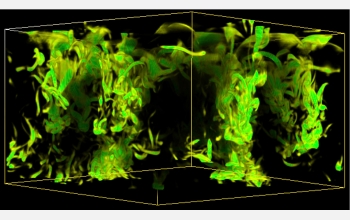Multimedia Gallery
Solar Convection and Entropy (Image 4)
Using models to understand the convection and magnetic flux near the solar surface, vorticity and turbulence are mainly confined to the intergranular lanes and downdrafts.
Robert Stein, a physics and astronomy professor at Michigan State University, and Aake Nordlund of Copenhagen University Observatory in Denmark, used the National Computational Science Alliance's SGI Origin2000 supercomputer, located at the National Center for Supercomputing Applications (NCSA), to create massive models of portions of the sun to simulate the processes behind the sun's smaller-scale features. Using these models, the team focused on understanding convection and magnetic flux near the solar surface. Stein and Nordlund have used supercomputers to study the nature of the sun for more than 15 years.
Rather than create the simulation through a variety of modeling applications, the team uses a single, integrated code based on the laws of conservation of mass, momentum and energy, as well as the forces of pressure, gravity and the magnetic field. Solving the equations that represent these laws and forces allows the researchers to see the essential physics at work, the radiative cooling at the surface that drives convection and the turbulent motions that generate small-scale, magnetic fields and shuffle them around, for example. On four to six Origin2000 processors, it takes about one day to simulate 30 seconds of time on the sun. Eventually, they hope to simulate about one day on the sun. Using the team's newest simulations, they hope to learn how much small-scale magnetic flux is generated by convection, how larger-scale structures are related to granulation, and how to calibrate sound waves to observe phenomena near the solar surface.
This work was supported by grants from the National Science Foundation (AST 95-21785 and AST 98-19799), NASA and the Danish Research Council. [Image 4 of 4 related images. Back to Image 1.]
Credit: Robert Stein, Physics and Astronomy Department, Michigan State University; and Aake Nordlund, Astronomy Observatory, Copenhagen University, Denmark. Calculations performed at the National Center for Supercomputing Applications, Michigan State University
Images and other media in the National Science Foundation Multimedia Gallery are available for use in print and electronic material by NSF employees, members of the media, university staff, teachers and the general public. All media in the gallery are intended for personal, educational and nonprofit/non-commercial use only.
Images credited to the National Science Foundation, a federal agency, are in the public domain. The images were created by employees of the United States Government as part of their official duties or prepared by contractors as "works for hire" for NSF. You may freely use NSF-credited images and, at your discretion, credit NSF with a "Courtesy: National Science Foundation" notation.
Additional information about general usage can be found in Conditions.
Also Available:
Download the high-resolution JPG version of the image. (580 KB)
Use your mouse to right-click (Mac users may need to Ctrl-click) the link above and choose the option that will save the file or target to your computer.



